Oh look, it’s a game with a strong Mega Man influence, a well-implemented dash mechanic, some similarities to Kirby and DuckTales, and such a love for random references that even the name is a reference to Destroy All Monsters. Since I am rather fond of everything I just named, it’s far from surprising that thoroughly enjoyed the time I spent playing the punch-filled amalgamation that is Khimera: Destroy All Monster Girls.
The protagonist this time around is Chelshia, a chimera created by a scientist for house cleaning and then modified for combat (sounds a bit familiar, doesn’t it?) in order to fight off pirates who stole all the money from an island town populated by peaceful monsters. Even though many parts of this game resemble Mega Man, Chelshia’s combat modification comes in the form of an enormous golem hand, which gives her a unique fighting style. The primary form of attack is to rapidly punch at close range or to throw a stronger, slower punch and both of these attacks are capable of blocking or reflecting many of the projectiles in the game. The golem arm can also be used in the air to perform a downward pogo attack which allows Chelshia to bounce off of the heads of her enemies and a seismic slam attack can be used while on the ground, which deals a large amount of damage and becomes significantly more useful as the game goes on, but it can be hard to actually land a hit with it. Of course, Chelshia’s most impressive and useful ability is her dash.
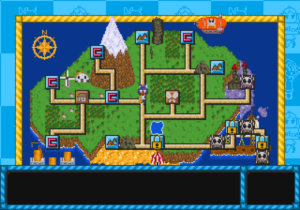
Dashing in Khimera isn’t as outright essential for combat as it is in games like Psi Knuckle and Noitu Love 2, but it packs a ton of utility and much of the platforming is designed around it. This is a purely horizontal dash attack which can be used both on the ground and in the air with a brief delay between uses (or no delay at all while on the ground if you get the timing just right). Getting accustomed to the exact length of the dash and learning to account for that brief delay between dashes is very important in order to avoid overshooting or undershooting jumps. What’s more, Chelshia is immune to non-magical forms of damage while dashing, and the game will often ask you to precisely dash across short stretches filled with spikes, but that invulnerability goes away the moment the dash ends and I learned the hard way that trying to spam dash attacks at enemies which take more than one hit is a great way to lose a significant chunk of your healthbar; dashing is useful and fun, but you need to make use of Chelshia’s full arsenal of abilities to play effectively. Overall, the strengths and deliberately designed weaknesses of the dash attack may punish you through both the platforming and the combat for mindlessly spamming it, but you’ll still find plenty of opportunities to make use of this entertaining and essential technique, especially if you are playing through the built-in time attack mode.
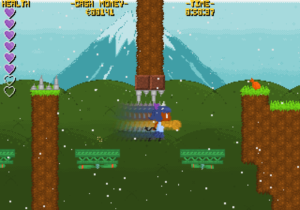
Progression in Khimera comes in many forms, though the most straightforward of them is stage completion. In addition to the town hub, a fairy area, and the intro stage, the world map allows you to choose from four main stages in any order. Most stages have about four checkpoints, which come in the form of a gorgon holding a Checkpoint sign whom you can talk to in order to receive some flavor text or useful hints for upcoming areas, and you have infinite lives so there isn’t much pressure when it comes to simply finishing the game. In fact, the difficulty is generally moderately low and forgiving; pits and a few other hazards are instantly fatal, but you start with four hearts and most enemies only take off half a heart (and have a chance of dropping healing food on defeat) and even spikes only take off a single heart. Finishing all four of the initial stages will grant access to the pirates’ ship, which consists of three levels which must be completed in order, much like the typical fortress levels in Mega Man. However, each of the four stages has a hidden detonator to find which will unlock a new ‘EX’ stage. These extra stages are much shorter than the normal stages and only one of them has a boss fight at the end, but they each provide a substantial challenge, such as in the case of one extra stage which takes place in a tower with a rapidly-rising floor of fatal spikes.

Remaining somewhat true to form, finishing each of the eight stages grants Chelshia a new ability. You don’t need to toggle between these abilities like subweapons as they generally serve more as enhancements for Chelshia’s existing moves. For example, by the end of the game the seismic attack will be able to send out a damaging shockwave along the ground in both directions in addition to temporarily revealing any secrets in the area. There’s also a medium-range charge shot and an extremely close-range upward thrust, both of which serve as substantial, if somewhat situational, additions to the already respectable library of attacks at your disposal to help with taking out enemies which would otherwise be much more threatening. However, the most substantial upgrade by far comes in the form of a pair of wings gained from completing the airship level. These wings don’t allow you to fly, but they do provide a very small upward boost the first time they are used while in the air and future uses within the same leap slow your descent without the added boost. The initial boost is the most notable feature of these wings as it is often just enough to allow you to reach previously inaccessible ledges and it can be a lifesaver if you miss a platform while dashing. Though some abilities are definitely more useful than others, the fact that each of them enhances or complements your existing capabilities ensures that you’ll get at least some use out of all of them and plenty of use out of many.
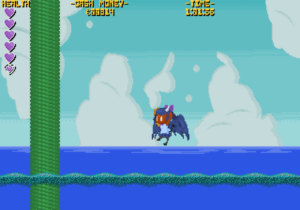
Khimera may have the structure of Mega Man, but it has the ‘easy to finish, difficult to complete’ mentality of a Kirby game. It’s entirely possible to simply rush through every stage until you defeat the final boss and still get quite a lot of enjoyment out of the game, yet you would be missing out on the most difficult and interesting challenges the game has to offer. Each stage is littered with breakable walls, often marked with cracks or other suspicious characteristics, and hidden paths to discover. Sometimes it can actually be difficult to tell if a drop is a path or just a death pit, and a few of my earliest deaths came from deliberately jumping into pits which I thought must be optional areas, but the game is generally good at making the distinction clear enough. Though a few of these secrets lead to the detonators which unlock the EX stages, there are quite a few other reasons to seek them out.
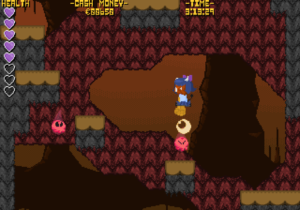
There are 25 trapped fairies to find scattered throughout the game, and the secret reward for finding all of them is easily worth the effort, in addition to dozens of information cards which you can take back to an NPC in the town to get quite a lot of flavor text for the characters and enemies. Sometimes all it takes to get a card is to destroy a wall and at other times you just need to go one way when the clear path forward is in the other direction to find a fairy, but in most cases you need to do some pretty tight platforming across instant death or between moving platforms and through corridors or fight against some particularly well-positioned enemies to claim your prize. There’s even a handy ability you can obtain by doing a fetch quest in the town, a few hidden costumes, and a secret location in each of the four main stages where you can encounter Gourmet Gal, who permanently boosts your health by one full heart, doubling your maximum health if you can find her all four times. A good chunk of these secrets require the wing upgrade to reach, making it a good idea to go after it as soon as you can, and not all of them are as easy to find as looking for a crack in a wall so you can expect to need to backtrack to several stages if you are aiming for 100% completion.
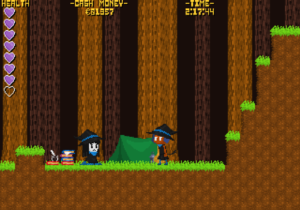
Thankfully, the game takes a few steps beyond the fairly generous checkpointing to help you out with its collectibles. The information for each stage on the world map includes empty boxes for fairies and cards so you can count exactly how many secrets are present before going in. As the boxes are combined in a single line, you won’t know the exact ratio of fairies to cards on your first run, but the leftmost boxes are always dedicated to fairies so you can figure out exactly how many of each you’re missing and their general locations once you have a box with a fairy followed by a box with a card. For example, if there is a stage with nine collectibles and after finishing it the first four boxes contain a fairy, a blank, another fairy, and then a card, you can figure out that there are a total of three fairies and six cards in the stage and you are missing a fairy which is hidden somewhere between the locations of the other two fairies which you have obtained. Furthermore, you keep any fairies and cards you find even if you die before reaching a new checkpoint or if you exit the stage early, so you don’t need to worry about going through an entire stage all over again just because you missed something right at the start.
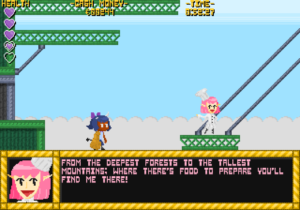
The final, and certainly the most numerous and challenging, collectible is the island’s treasure itself. The treasure being stolen by pirates it’s just a plot point, it’s an entire mechanic as every stage has plenty of coins and gems to find. You are graded at the end of every stage based on the amount of treasure you have collected and the town’s treasure vault gradually fills up as you earn higher grades, but the only way to get an ‘A’ is to get 100% of the treasure in a stage. Treasure is absolutely everywhere in each stage, sometimes in plain sight along the mandatory path, sometimes on a platforming which requires some light puzzle solving or precision platforming to reach, and often behind walls or in hidden rooms. Unlike other collectibles, treasure is counted on a per-run basis, so getting an ‘A’ means getting all of the treasure in a single attempt. To make things more challenging still, every fairy leaves behind a valuable diamond, meaning you need to go through their often-challenging rooms to get full completion even if you’ve already saved the fairy on a previous attempt, and you’ll lose a small portion of your gold every time you die. This death penalty sounds remarkably harsh considering you need to get a 100% rating for an A, but it is offset somewhat by two factors. First, treasure respawns after you die and the amount lost is insubstantial enough that unless you’ve died immediately after hitting a checkpoint you can usually get all or most of it back by the time you reach the point where you died. Secondly, it is actually possible to go over 100% in every stage because enemies drop small, slightly randomized amounts of treasure which isn’t part of the initial 100%; you won’t offset a string of deaths or missing a room containing multiple gems with the treasure from enemies, but it’s almost always enough to make up for missing a small secret or dying once or twice. Collecting treasure is ultimately entirely optional, but this and the other optional goals give Khimera a very organic form of adjustable difficulty, making it both a fairly easy or a substantially more difficult game depending entirely upon what you want to do as the player.
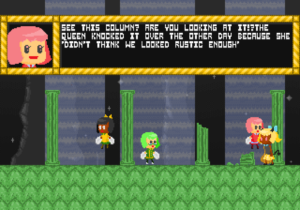
Khimera is a very charming game and it is clear that a lot of hard work and careful polish went in to creating that charm. The town is filled with NPC’s to talk to and gradually gains more as the game progresses even though you can go through the entire game without visiting it a single time. Every character has a portrait alongside their dialogue boxes with plenty of different emotions for the entire main cast (and even some of the minor characters); bosses get a good bit of dialogue before each of their respective fights, but they also stick around to talk to in one place or another after you defeat them. Chelshia in particular has plenty of personality both in her dialogue and in her sprite while platforming and the cartoonish aesthetic fits the game like a very cozy glove. There is even quite a bit of effort put in to small things which are easy to miss, such as the fact that you can even talk to the checkpoint gorgon in the first place and the inclusion of an actual island map to move around rather than a bland stage select screen is very welcome.
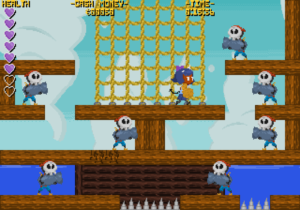
Khimera: Destroy All Monster Girls may appear to be a typical Mega Man-style game on the surface, but it ultimately provides enough twists to the formula to create a unique and charming experience which will appeal to completionists and speedrunners alike as well as just about anyone in-between.